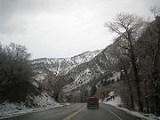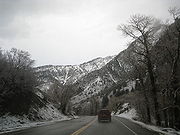
Big Cottonwood Canyon
Encyclopedia

Canyon
A canyon or gorge is a deep ravine between cliffs often carved from the landscape by a river. Rivers have a natural tendency to reach a baseline elevation, which is the same elevation as the body of water it will eventually drain into. This forms a canyon. Most canyons were formed by a process of...
in the Wasatch Range
Wasatch Range
The Wasatch Range is a mountain range that stretches approximately from the Utah-Idaho border, south through central Utah in the western United States. It is generally considered the western edge of the greater Rocky Mountains, and the eastern edge of the Great Basin region...
12 miles (19.3 km) southeast of Salt Lake City
Salt Lake City, Utah
Salt Lake City is the capital and the most populous city of the U.S. state of Utah. The name of the city is often shortened to Salt Lake or SLC. With a population of 186,440 as of the 2010 Census, the city lies in the Salt Lake City metropolitan area, which has a total population of 1,124,197...
in the U.S. state
U.S. state
A U.S. state is any one of the 50 federated states of the United States of America that share sovereignty with the federal government. Because of this shared sovereignty, an American is a citizen both of the federal entity and of his or her state of domicile. Four states use the official title of...
of Utah
Utah
Utah is a state in the Western United States. It was the 45th state to join the Union, on January 4, 1896. Approximately 80% of Utah's 2,763,885 people live along the Wasatch Front, centering on Salt Lake City. This leaves vast expanses of the state nearly uninhabited, making the population the...
. The 15 miles (24.1 km)-long canyon provides hiking, biking, picnicking, rock-climbing, camping and fishing in the summer. During winter, its two ski resorts, Brighton
Brighton Ski Resort
Brighton Ski Resort is a ski area located in Big Cottonwood Canyon, from downtown Salt Lake City, Utah. Brighton Ski Resort was the first ski resort in Utah, and one of the first in the United States. Brighton was started in 1936 when members of the Alpine Ski Club built a rope tow from wire and...
and Solitude, are popular among skiers and snowboarders. The canyon is accessed by The Big Cottonwood Canyon Scenic Byway
Utah State Route 190
State Route 190 or the Big Cottonwood Canyon Scenic Byway is primarily an east and west scenic highway located in Salt Lake County, Utah that begins at I-215 and runs through Big Cottonwood Canyon including the Brighton Loop and ends at the Salt Lake and Wasatch County line.-Holladay and Cottonwood...
, which runs its length to Guardsman Pass at the top of the canyon, allowing travel to Park City
Park City, Utah
Park City is a town in Summit and Wasatch counties in the U.S. state of Utah. It is considered to be part of the Wasatch Back. The city is southeast of downtown Salt Lake City and from Salt Lake City's east edge of Sugar House along Interstate 80. The population was 7,558 at the 2010 census...
in the summer months.
During the winter months, Guardsman Pass is closed off, and is a popular snowshoe hiking destination for many Utahns.
Hiking to the canyon's mountain lakes is a popular activity, with many trails leading to lakes such as Mary, Martha and Katherine. The canyon's most popular hiking trail leads to Lakes Blanche, Florence and Lillian. The trail is 3.1 miles (5 km) long and is considered strenuous. Since the canyon was formed by Big Cottonwood Creek
Big Cottonwood Creek
Big Cottonwood Creek is one of the largest streams entering Salt Lake Valley from the east from the Wasatch Mountains. The creek flows through the Big Cottonwood Canyon in a westerly direction until it emerges into Salt Lake Valley about eighteen miles from its highest source...
, the V-shaped canyon has many impressive rock forms.
The canyon is also a frequent destination for Utah Native Plant Society
Utah native plant society
The Utah Native Plant Society is a non-profit organization dedicated to the appreciation, preservation, conservation and responsible use of the native plants and plant communities found in the state of Utah and the Intermountain West. Its goal is to foster public recognition of the spectacularly...
led wildflower walks and for University of Utah
University of Utah
The University of Utah, also known as the U or the U of U, is a public, coeducational research university in Salt Lake City, Utah, United States. The university was established in 1850 as the University of Deseret by the General Assembly of the provisional State of Deseret, making it Utah's oldest...
botanical field trips. The canyon and the adjoining Little Cottonwood Canyon
Little Cottonwood Canyon
Little Cottonwood Canyon lies within the Wasatch-Cache National Forest along the eastern side of the Salt Lake Valley, roughly 15 miles from Salt Lake City, Utah. The canyon is part of Granite, a CDP and “Community Council” designated by Salt Lake County. The canyon is a glacial trough , carved by...
contain significant biodiversity
Biodiversity
Biodiversity is the degree of variation of life forms within a given ecosystem, biome, or an entire planet. Biodiversity is a measure of the health of ecosystems. Biodiversity is in part a function of climate. In terrestrial habitats, tropical regions are typically rich whereas polar regions...
and are home to a number of rare and endemic plant species. One example is the Wasatch shooting-star, Dodecatheon dentatum var. utahense which is only known from Big Cottonwood Canyon.
Big Cottonwood Canyon is a watershed
Drainage basin
A drainage basin is an extent or an area of land where surface water from rain and melting snow or ice converges to a single point, usually the exit of the basin, where the waters join another waterbody, such as a river, lake, reservoir, estuary, wetland, sea, or ocean...
canyon that supplies drinking water to the Wasatch Front
Wasatch Front
The Wasatch Front is a metropolitan region in the north-central part of the U.S. state of Utah. It consists of a chain of cities and towns stretched along the Wasatch Range from approximately Santaquin in the south to Brigham City in the north...
, therefore pets and other domesticated animals are not allowed.
In spring, it is not uncommon for the snow to reach 15 feet (4.6 m) deep at the top end of the canyon while there is none at the mouth of the canyon less than 15 miles (24.1 km) away.
Storm Mountain
Storm Mountain is a popular picnicPicnic
In contemporary usage, a picnic can be defined simply as a pleasure excursion at which a meal is eaten outdoors , ideally taking place in a beautiful landscape such as a park, beside a lake or with an interesting view and possibly at a public event such as before an open air theatre performance,...
site. Over one hundred years ago R.D. Maxfield, Jr. carved out a home for himself and his family. It soon became a relaxing place for picnics. In the 1930s the Civilian Conservation Corps
Civilian Conservation Corps
The Civilian Conservation Corps was a public work relief program that operated from 1933 to 1942 in the United States for unemployed, unmarried men from relief families, ages 18–25. A part of the New Deal of President Franklin D...
built a small stage area for public events.
The Storm Mountain area is also notable geologically for its rhythmite
Rhythmite
A rhythmite consists of layers of sediment or sedimentary rock which are laid down with an obvious periodicity and regularity. They may be created by annual processes such as seasonally varying deposits reflecting variations in the runoff cycle, by shorter term processes such as tides, or by longer...
s (a sea-level sedimentary deposit that records the cycle of the tides) and cross-bedded sandstones.
S-Curve Area
S-Curve Area is a popular rock climbing area in Big Cottonwood Canyon. Most of the routes are bolted and offer a variety of grades. Most distinctive about this climbing area are the impressive overhangs that exist on many of the routes. The S-Curve Area is located just 4.25 miles (6.8 km) from the mouth of the canyon.External links
- Big Cottonwood Canyon. Utah Pictures.

